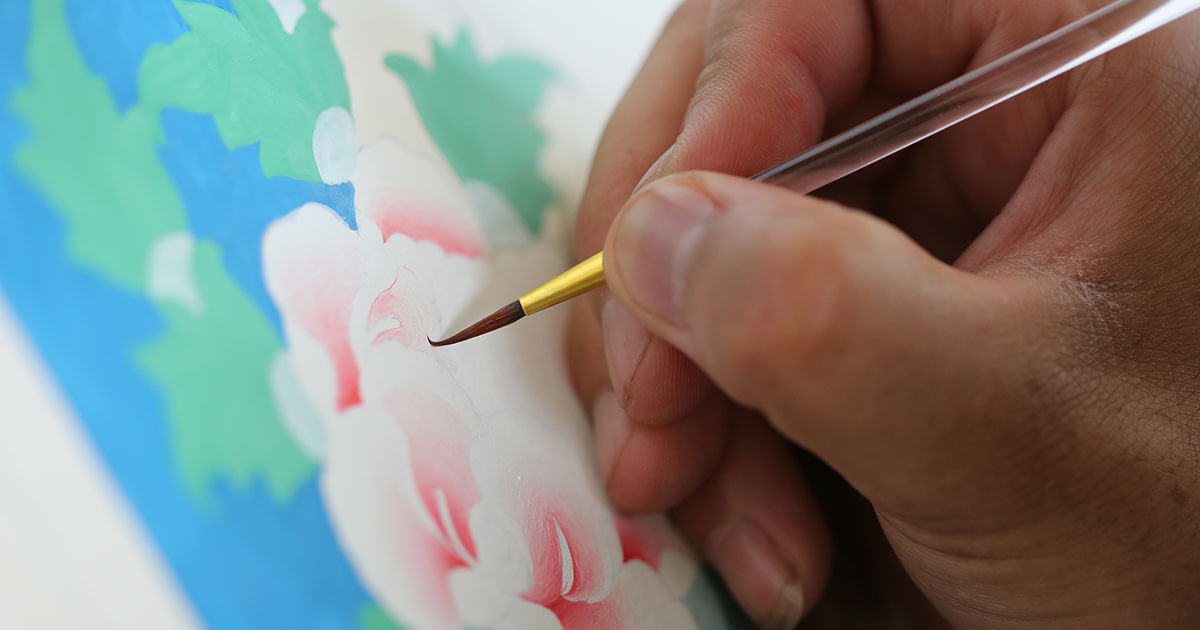For many traditional Tibetan artists, painting a deity is an act of worship. Painters Shawo Dukgyal and Shawo Thar work in Rebgong, a region famous for its thangkas, traditional Tibetan scroll paintings. Most often religious in nature, thangkas are a form of visual scripture. They depict buddhas, bodhisattvas (enlightened beings), and teachers, and illustrate their sacred stories and as well as the principles they embody. As both objects of worship and expressions of religious ideals, thangkas are a central feature in monastic shrines as well as in domestic altars.
Traditionally, painters wash their hands and light incense to purify themselves and their environment before starting to paint. The painting process follows a set sequence: first, they stretch white cotton or linen on a frame and apply gesso or chalk. Then they smooth out the surface and burnish it with a stone. The image begins with an outline either in black or red ink, then the painted background, and finally the central figure—first the body, then the facial features. Then the painting is gilded, or embellished with gold leaf. Upon completion, the artist mounts the painting on silk. Older thangkas were mounted on simple, dark blue silk or cotton, but now they often use printed silk brocades or polyester.

Painting Buddhist deities requires following the age-old tradition of iconometry, a system of bodily proportions and measurements used in creating the specific outlines of each deity. Beginning painters use a grid called a tik-khang, meaning “house of lines.” These measurements guide the painter in how to render the figure, the body postures known in Sanskrit as asanas, and their hand gestures, called mudras. Apprentices spend years learning the iconometrics as well as the stories and characteristics of various deities and human figures. As painters gain skill, they internalize the grid. While the iconometrics of the figures are fixed, painters have some creative liberty in rendering the background: the narrative stories, the decorative elements, and the landscape.
Artists traditionally collaborate in atelier-style workshops. Few thangkas are completely hand-painted by one artist. A master painter often oversees many paintings. His students paint the bigger swaths of color or the more decorative elements, while the master will step in to do the finer brushwork or the intricate details on the face or hands.
At the other end of the production spectrum, companies mass-produce thangkas in factories by printing images on canvas with acrylic paint. Right now, most thangka production in Western China falls in the middle of the spectrum, where artisans hand-paint some parts of the thangka, and machine-print the rest to speed up the process. Although LaserJet printing marks a departure from the traditional process, semi-mechanized production is a means to meet an increasing demand for painted works for non-religious use.
Shawo Dukgyal and Shawo Thar, however, follow tradition and use mineral pigments made from coral, malachite, sapphire, pearl, and gold to paint their thangkas. In the past, painters made their own brushes out of fine hair from goats and other animals. Now it is more common to use store-bought brushes and synthetic paint.











The Chinese thangka market runs the gamut from souvenir to fine art. In Lhasa and Chengdu, LaserJet printed thangkas are sold to trekkers in open-air markets while collectors from Beijing commission new works or hunt for rare antiques. Trading in thangkas, both contemporary and antique, is lucrative business. Traders often buy directly from painters in rural areas at low prices and resell them to Chinese dealers who then sell at even higher prices in China and abroad.
To meet an ever-growing demand, more people are learning to paint, resulting in some budding concerns that the market has commodified a sacred tradition.
Some feel that the younger generation has learned the skill but not acquired the religious or cultural knowledge that accompanies it. To study thangka painting is, in many ways, to become a student of Buddhism. Shawo Thar says, “As a thangka painter, I need to study thangka literature as well as the actual painting skills.”
Many artisans chant prayers while they work. Now the younger generation is more likely to be listening to the radio. This shift can become even more contentious when a painter does not follow iconometrics, and a sacred deity is depicted with different symbols or in a different pose than what texts and tradition prescribe.
“If a thangka painter is not knowledgeable, they will likely make mistakes,” Shawo Thar says. Sometimes, non-Buddhist patrons commission works that flout religious norms, such as ordering a painting of a Green Tara with a sword.
Yet patronage, both private and monastic, has always been part of the thangka economy. Painters have always balanced the sacred nature of their work with external demand. Currently, the increased demand has also provided much-needed livelihood for many Tibetans in both rural and urban settings.
The very last step in the thangka process is the consecration ritual. Monks chant, pray, and invoke the deity depicted. The eyes are then “opened” by painting in the pupils, and then an artist inscribes “om ah hum” (“body, mind, speech”) on the back of the scroll. Once consecrated, the thangka is no longer a painting—the deity inhabits the body of the figure. The image is brought to life. To most tourists and collectors, they are paintings of buddhas. To Tibetans, they are the buddhas themselves.




